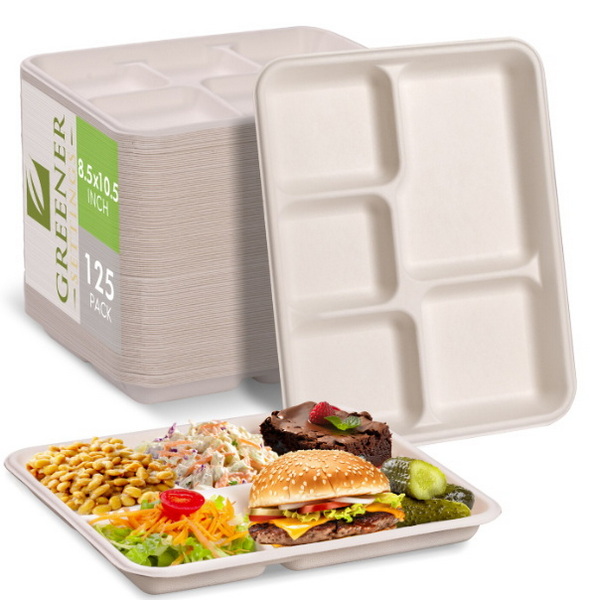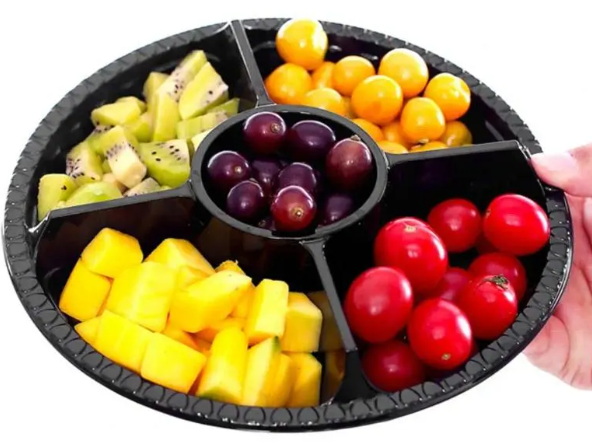
Content Menu
● Introduction to Disposable Trays with Lids
>> Materials Used in Disposable Trays
● Benefits of Disposable Trays with Lids
>> How Lids Contribute to Freshness
● Applications of Disposable Trays with Lids
● Environmental Considerations
>> Eco-Friendly Alternatives
● Innovations in Disposable Trays
● Consumer Preferences and Trends
● Challenges and Future Directions
● Conclusion
● FAQ
>> 1. What materials are disposable trays with lids made of?
>> 2. How do lids help keep food fresh?
>> 3. Are all disposable trays with lids microwave-safe?
>> 4. What are the environmental benefits of using biodegradable trays?
>> 5. Can disposable trays with lids be used for hot meals?
Disposable trays with lids have become an essential tool in the food industry, particularly for takeaways, catering services, and outdoor events. These trays are designed to keep food fresh by providing a secure, leak-proof environment that maintains the quality of the food until it is consumed. In this article, we will explore the benefits and functionalities of disposable trays with lids, including their design, materials, and applications.

Introduction to Disposable Trays with Lids
Disposable trays with lids are made from various materials, including plastic, cardboard, and biodegradable alternatives like cornstarch or bagasse. The choice of material depends on the intended use, environmental considerations, and cost factors. For instance, plastic trays are widely used due to their durability and affordability, while biodegradable options are gaining popularity for their eco-friendly attributes.
Materials Used in Disposable Trays
1. Plastic Trays: These are the most common type, made from materials like polypropylene (PP), polystyrene (PS), or polyethylene terephthalate (PET). They are lightweight, easy to stack, and resistant to grease and oils. Plastic trays are versatile and can be used for both hot and cold foods, making them ideal for a wide range of applications.
2. Biodegradable Trays: Made from materials such as cornstarch or bagasse, these trays are compostable and reduce environmental impact. However, they may not be suitable for all types of food, especially those with high moisture content. Biodegradable trays are a step towards sustainability but require careful handling to ensure they do not degrade prematurely.
3. Cardboard Trays: These are lightweight and versatile, often used in fast food and bakery settings. They can be microwaveable but are not suitable for high-fat or high-moisture foods. Cardboard trays are cost-effective and can be customized with branding or designs, making them popular for promotional events.
Benefits of Disposable Trays with Lids
Disposable trays with lids offer several benefits that make them indispensable in modern food service:
1. Convenience: They eliminate the need for washing and reusing containers, making them ideal for on-the-go meals or events where convenience is key. This convenience factor is particularly important in busy urban environments where time is of the essence.
2. Hygiene: Being single-use, they reduce the risk of cross-contamination and maintain high hygiene standards. This is crucial in environments where food safety is paramount, such as hospitals or schools.
3. Portability: Lightweight and easy to carry, these trays are perfect for travel or outdoor activities. They are often used in picnics, camping trips, or festivals where mobility is essential.
4. Cost-Effectiveness: Generally cheaper than reusable containers, they are a cost-effective option for businesses looking to minimize expenses without compromising on quality.
5. Variety: Available in various shapes and sizes, they can accommodate different types of food, from sandwiches to hot meals. This versatility makes them suitable for a wide range of cuisines and dining settings.
How Lids Contribute to Freshness
The lids on disposable trays play a crucial role in maintaining food freshness:
- Sealing: They prevent air from entering the container, reducing oxidation and preserving the organoleptic properties of the food. This is particularly important for foods that are sensitive to air exposure, such as salads or fruits.
- Moisture Control: By keeping moisture out, lids help prevent sogginess and spoilage, especially in humid environments. This is vital for maintaining the texture and flavor of foods like baked goods or fried items.
- Temperature Preservation: Some lids are designed to maintain the temperature of the food, ensuring it remains hot or cold for longer. This feature is beneficial for takeaway services where food needs to be consumed at the right temperature.

Applications of Disposable Trays with Lids
Disposable trays with lids are versatile and can be used in various settings:
1. Catering and Events: They are ideal for buffets, weddings, and corporate events where food needs to be transported and served efficiently. The use of disposable trays with lids simplifies the logistics of food service at large events.
2. Takeaway and Delivery: Perfect for packing meals with multiple components, such as Chinese or Indian dishes, without mixing flavors. This ensures that each component of the meal remains distinct and flavorful.
3. Outdoor Activities: Suitable for picnics, camping, or festivals where convenience and hygiene are essential. Disposable trays with lids are easy to dispose of, reducing litter and environmental impact.
Environmental Considerations
While disposable trays with lids offer many benefits, their environmental impact cannot be ignored. The rise of biodegradable materials is a step towards reducing plastic waste. However, even biodegradable options have limitations, such as not being suitable for all types of food.
Eco-Friendly Alternatives
1. Cornstarch Trays: These are compostable and can replace traditional plastic trays in some applications. Cornstarch trays are made from renewable resources and are biodegradable, reducing the carbon footprint associated with food packaging.
2. Bagasse Trays: Made from sugarcane pulp, they are biodegradable but may not be suitable for high-moisture foods. Bagasse trays are durable and can withstand high temperatures, making them suitable for hot meals.
Innovations in Disposable Trays
The industry is witnessing innovations aimed at making disposable trays more sustainable and functional:
1. Recyclable Materials: Some companies are developing trays made from recyclable materials, which can be collected and reused, reducing waste.
2. Compostable Lids: Compostable lids are being introduced to complement biodegradable trays, ensuring that the entire packaging is environmentally friendly.
3. Smart Packaging: Some trays are designed with smart packaging features, such as temperature indicators or freshness sensors, to enhance food safety and quality.
Consumer Preferences and Trends
Consumer preferences are shifting towards more sustainable and eco-friendly packaging options. This trend is driving the demand for biodegradable and compostable disposable trays with lids. Additionally, consumers are looking for packaging that is not only environmentally friendly but also visually appealing and functional.
Challenges and Future Directions
Despite the benefits of disposable trays with lids, there are challenges to overcome, particularly in terms of environmental sustainability. The future of disposable trays lies in developing materials that are both functional and eco-friendly. Research into new biodegradable materials and recycling technologies will play a crucial role in shaping the industry.
Conclusion
Disposable trays with lids are a convenient and hygienic solution for food storage and transport. They offer a range of benefits, from maintaining food freshness to being cost-effective and portable. However, it's important to consider the environmental impact and opt for eco-friendly alternatives when possible. As technology advances, we can expect to see more sustainable options emerge in the market.

FAQ
Here are some frequently asked questions about disposable trays with lids:
1. What materials are disposable trays with lids made of?
Disposable trays with lids are made from a variety of materials, including plastic (such as PP, PS, PET), biodegradable materials like cornstarch or bagasse, and cardboard.
2. How do lids help keep food fresh?
Lids help keep food fresh by sealing the container, preventing air from entering, and maintaining the temperature of the food. This reduces oxidation and spoilage.
3. Are all disposable trays with lids microwave-safe?
Not all disposable trays with lids are microwave-safe. It depends on the material used; some plastics are safe for microwave use, while others are not.
4. What are the environmental benefits of using biodegradable trays?
Biodegradable trays reduce plastic waste and are compostable, which helps minimize environmental impact compared to traditional plastic trays.
5. Can disposable trays with lids be used for hot meals?
Yes, many disposable trays with lids are suitable for hot meals. They are designed to withstand heat and maintain the temperature of the food.

















